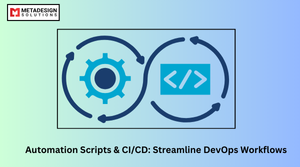Building software can be a daunting task, especially when you’re close to wrapping up development on your latest project. The pressure to not release buggy code is always lurking around the corner, ready to pounce and ruin all of your hard work. Continuous Integration (CI) and Continuous Deployment (CD) provide an excellent way to feel that pressure easing up a bit thanks to automatic testing, deployment scripts, and the easy opportunity for feedback from other developers. Ready to make use of CI and CD? Keep reading – it’s much easier than you’d think!
What is Continuous Integration?
Continuous Integration (CI) is a development practice that requires developers to integrate code into a shared repository several times a day. Each check-in is then verified by an automated build, allowing teams to detect problems early.
While CI can be used with any programming language or development approach, it is often used in conjunction with Agile and Test-Driven Development (TDD).
What is Continuous Deployment?
If you’re not familiar with the term, continuous deployment is the practice of automatically deploying code changes to a production environment. This means that every time a developer makes a change, it is immediately pushed to production, rather than going through a separate QA or staging process.
There are a number of benefits to this approach. First, it helps to ensure that code changes are released quickly and efficiently. Developers don’t need to wait for approval from QA before their code goes live, which can speed up the overall release process. Additionally, it helps to reduce the risk of bugs and errors introduced by code changes. By putting code changes into production immediately, you can catch errors more quickly and fix them before they cause major problems.
Overall, continuous deployment is a good way to improve your release process and reduce risk. If you’re not already doing it, you should consider adopting this practice in your own organization.
Achieve Faster Deployments with CI/CD
Ready to enhance your development pipeline with Continuous Integration and Deployment? Book a consultation today to explore how CI/CD can increase your team’s efficiency and delivery speed.
Why do you need Continuous Integration and Deployment?
Continuous integration is a process in which all development work is integrated as early as possible. This practice reduces the risk of developers working in isolation and introduces opportunities for automated testing which can catch errors quickly.
Deployment is the process of pushing code changes to a production or staging server. This usually happens automatically after code is merged into a central repository. Continuous deployment goes one step further by automatically deploying code changes whenever they are made.
There are many benefits to using continuous integration and deployment, including:
Increased speed and efficiency: Automating the build and deployment process saves time and reduces the chance for human error.
Improved quality: Automated testing can catch errors that might otherwise go unnoticed.
Reduced risk: Deploying small changes frequently reduces the risk of introducing major errors into the production environment.
Better collaboration: By integrating early and often, developers can avoid merge conflicts and resolve issues quickly.
How does CI/CD work?
Continuous integration and continuous delivery (CI/CD) are two of the most important processes in modern software development. CI/CD automate and accelerate the software development cycle, making it much easier and faster for developers to get new features and updates into the hands of users.
In a nutshell, CI/CD is all about automating the software development process from start to finish. Developers check code into a central repository where it is built, tested, and deployed automatically. This allows for faster iteration times and ensures that all code changes are thoroughly tested before they are released.
There are many benefits to using CI/CD, including:
Shorter development cycles:
Automating the build, test, and deploy process saves time and accelerates the overall development cycle.Reduced risks:
Automated testing can help catch errors and bugs early on, before they make it into production.Increased quality:
By automating the release process, you can ensure that all code changes go through a rigorous testing process before they are made available to users.Improved team collaboration:
CI/CD helps developers work together more effectively by providing a centralized place forcode collaboration and sharing.
What tools can I use for CI/CD?
There are a variety of continuous integration and delivery tools available today, each with its own strengths and weaknesses. Some of the popular options include Jenkins, Bamboo, TeamCity, and GoCD.
Choosing the right tool for your organization depends on a number of factors, including the size and complexity of your project, the languages and technologies you’re using, and your team’s preferences.
One of the benefits of using a CI/CD tool is that it can automate many of the tasks associated with building, testing, and deploying software. This can save your team a lot of time and effort, and allow them to focus on more important tasks.
Another benefit is that CI/CD tools can help to ensure that your software is always up-to-date and compliant with the latest standards. This can help to avoid potential problems down the road.
If you’re considering using a CI/CD tool for your next project, be sure to do your research and choose one that will fit your needs.
Related Keyphrase:
#ContinuousIntegration #ContinuousDeployment #CICD #DevOps #SoftwareDevelopment #CIandCD #AutomatedTesting #AppDevelopment #DevOpsServices #TechSolutions #CIandCDTools #AutomatedDeployments #SoftwareAutomation #AppDevCompany #CIandCDServices #TechConsulting #HireDevOpsExperts #SoftwareDevelopmentCompany #TechInnovation #AppDevelopmentServices #HireSoftwareDevelopers #AutomatedIntegration #DevOpsIntegration #CloudServices #TechInDevOps #AppDeployment #SoftwareDelivery #DevOpsCompany #CustomSoftwareDevelopment #ContinuousIntegrationServices #AppSolutions #DevOpsBestPractices #CIandCDPipeline #SoftwareTesting #HireCIExperts #ContinuousDeploymentServices



